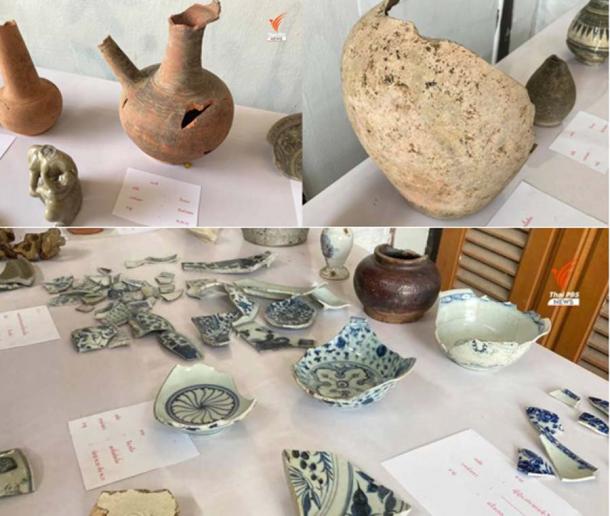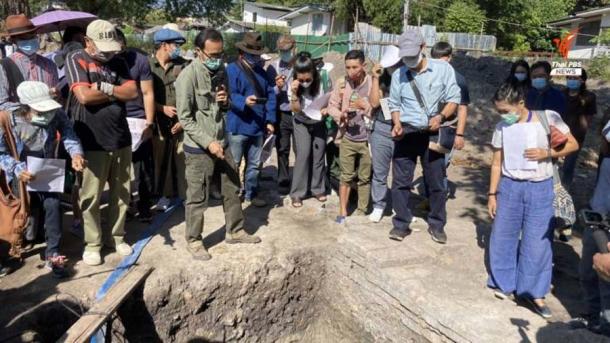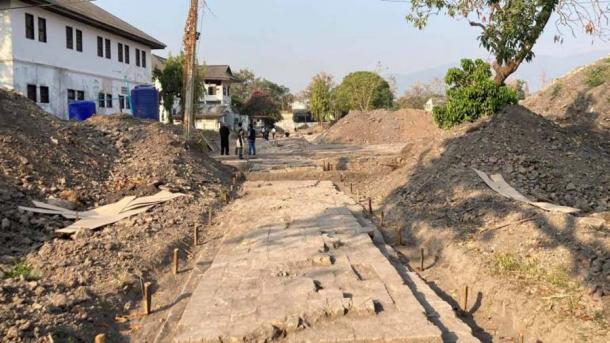During the demolition of a correctional center in Chiang Mai, Thailand, workers discovered what was once a palace structure. Now, below the site of Chiang Mai’s Women’s Correctional Center, a treasure trove of artifacts has been found. The find confirms the area’s links with the early Lan Na Kingdom of the Mangrai Dynasty.
Prison Demolition Led to Lan Na Kingdom Discovery
In the early 2000s, Chiang Mai Women’s Correctional Center was about to be demolished to make way for a park. Upon demolition, parts of an ancient palace that existed in Chiang Mai were uncovered. According to Thai PBS , these foundations are of an early Lan Na period palace.

Artifacts recovered from the site of the ancient Lan Na Kingdom palace so far. ( Thai PBS )
The extensive site is now deemed of such archaeological value that local professor, Thanet Charoenmuang, wants to open up discussions with residents in the area on what should be done with the discovery. Many artifacts, such as pottery fragments and wares have been found by archaeologists at Silpakorn University 7, including:
· Wares from the Jingdezhen oven (porcelain)
· Yuan Dynasty artifacts (13 th – 14th century)
· Vietnamese wares Tran-Ho (15th century
· Ceramics of Jingde, China (16th century)
· Vietnamese wares (21st Buddhist Century)
· Ming Dynasty wares (22nd Buddhist Century)
Ongoing discussions are taking place to determine how to use the area best. Many in the community want to develop the area into a park and remove the old prison buildings on the ground. However, due to the significant archaeological findings deemed to be part of the ancient city of Chiang Mai, historians and archaeologists want to preserve it. Thai PBS reports that the one consensus is that it should become a public area for use by everyone.

A large number of ≈ of the public sector, government agencies and academics, such as Prof. Thanet Charoenmuang, have visited the site of the ancient Lan Na Kingdom palace. ( Thai PBS )
Lan Na – Mangrai’s Northern Kingdom
Located in the north of Thailand, Lan Na was founded by Mangrai, the 25th king of Ngoenyang, as one of the first major Tai kingdoms. It emerged between the 13th and 18th centuries through the unification of all of the mueangs or principalities in Indochina.
According to Asia Highlights , its capital had initially been Ngoenyang, and then in 1262, Mangrai moved it to Chiang Rai, “the city of Rai,” which he named after himself. He then moved the capital to Wiang Kum Cam in 1287, but due to heavy flooding, Mangrai was forced to move once again eventually settled in Chiang Mai in 1296 making it the capital of the Lan Na Kingdom.
Upon his death in 1317, Mangrai was succeeded by his second son, Grama. His authority came into question, which caused much internal strife as Mangrai’s heirs fought for the right to the throne. This caused the capital to change back and forth until Pha Yu, one of Mangrai’s grandchildren, restored the capital to Chiang Mai in 1350.

Within an area that was once Chiang Mai’s Women’s Correctional Center, archaeologists have found multiple archaeological remains and artifacts belonging to an ancient Lan Na Kingdom palace. ( Thai PBS )
History of the Lan Na Kingdom
Lan Na, which translates as “Kingdom of a Million Rice Fields,” was heavily influenced by India and was central in the spread of Theravada Buddhism, which flourished under Pha Yu. Eventually, Saenmuengma ushered a new period of peace in Chiang Mai, but it was challenged by Borommaracha and Ming Dynasty rulers.
From about 1441 to 1487, under Tilokkarat, the Lan Na Kingdom reached its zenith. Tilokkarat helped to make the area famous for its Buddhist scholarship and literature. During his reign, he built and restored many temples. He enlarged Wat Chedi Luang, built Wat Pa Daeng and Wat Chen Yot. These temples display influences from China, Laos and India.
Decline of the Lan Na Kingdom
The Lan Na Kingdom began to decline in the 16th century. After Tilokkarat’s death, the Kingdom was susceptible to challenges from powerful neighboring kingdoms of Ayutthaya and Burma. Tilokkarat’s grandson, Paya Kaew, tried to maintain control over the kingdom, but unfortunately, it was invaded in 1513 and lost control of Kengtung State in 1523. In 1545, Paya Kaew’s granddaughter, Chiraprapha, became the queen regent.
Lan Na’s weak position made it even more susceptible to invasion and Ayutthaya forced it to become a vassal state. Chiraprapha abdicated shortly after and her nephew Chaiyasettha, who later became known as Setthathirath, seized power. After this, Mekuti became king.
The 17th century saw the rise of Burmese domination in Lan Na. Bayinnaung, the Burmese King, invaded Lan Na and Mekuti surrendered in 1588. A period of chaos erupted, but in 1596 Lan Na was able to become independent again for a short time before Burma returned to seize power and ruled it for nearly a century. The struggle to regain its power from Burma continued until the 18th century until Kawila captured the city in 1775.
What Does the Future Hold for the Lan Na Kingdom Palace Remains?
The discoveries in Chiang Mai are spectacular, but now both historians and the community must decide what to do with them. The dilapidated buildings are the primary concern, but both sides are pushing to have them torn down since they are of no historical importance. The most important part of the site in Thailand is the area along the Wiang Kaew wall which links the new building’s foundation to the remains of the original foundation from the Lan Na era, so perhaps this will be preserved for it’s historical value.
Those of an archaeological and historical bent will push to have the areas fully excavated and preserved as a site of historical interest. They will possibly even be campaigning to make the area a World Heritage Site. The area also may be developed as an open museum to promote tourism in the area. We’ll keep you posted!
Top image: Lan Na Kingdom palace remains have been uncovered in Chiang Mai, Thailand. Source: Thai PBS
By ML Childs
Related posts:
Views: 0
 RSS Feed
RSS Feed















 February 20th, 2021
February 20th, 2021  Awake Goy
Awake Goy  Posted in
Posted in  Tags:
Tags: 
















